Installation view at HEAD-Genève, Switzerland.
Original 3 channel video, 5760 x 1080p.




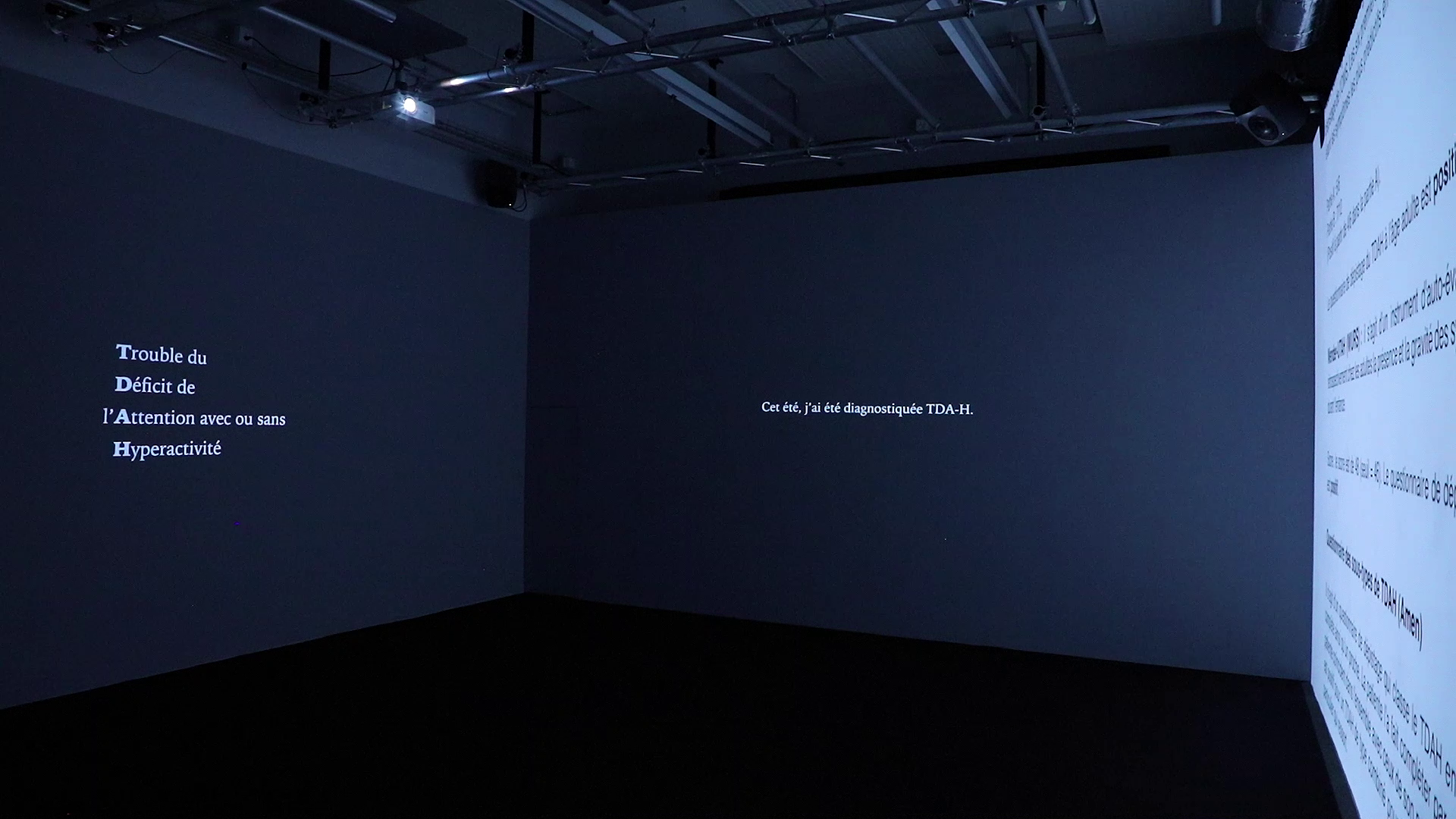


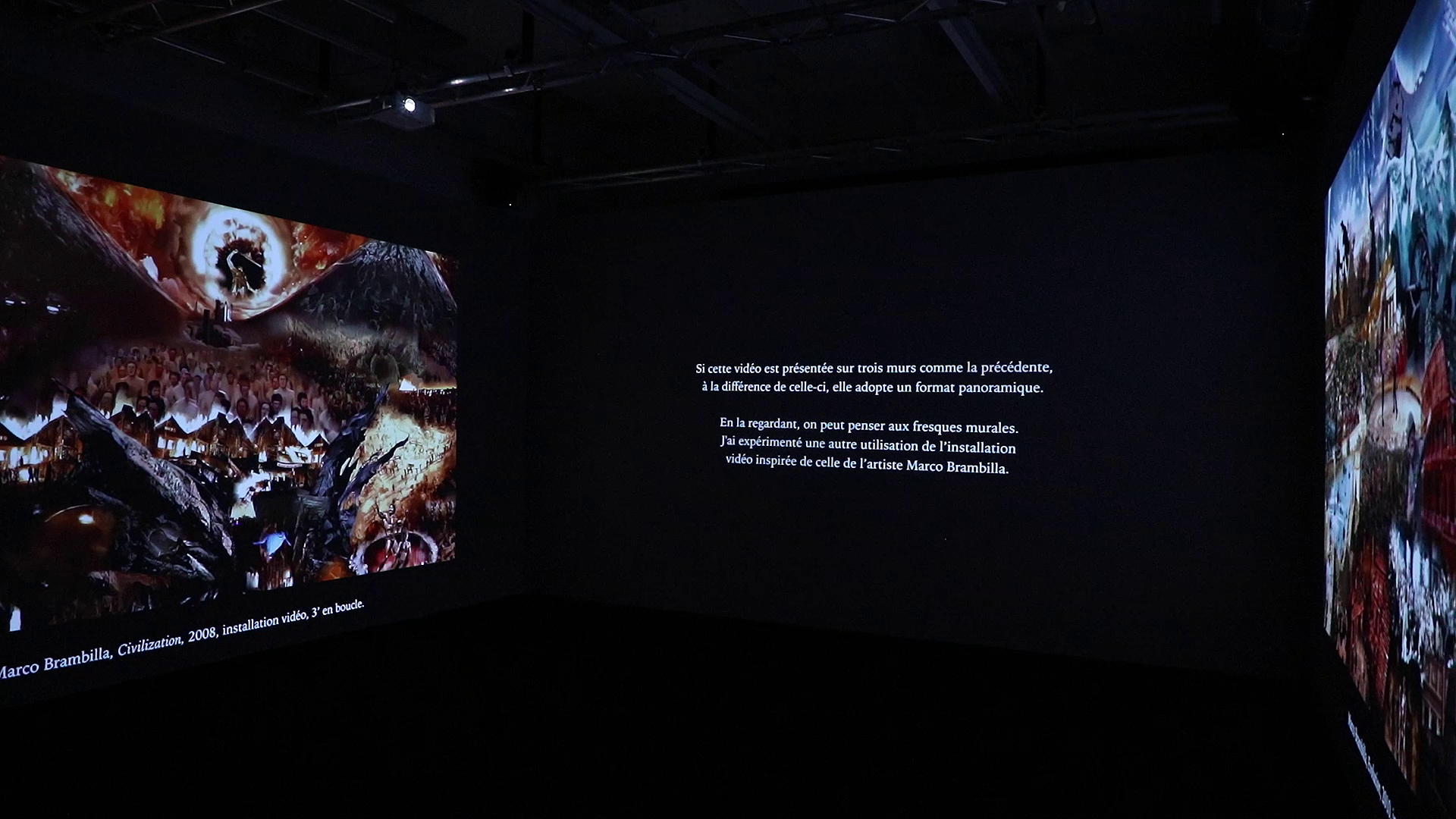




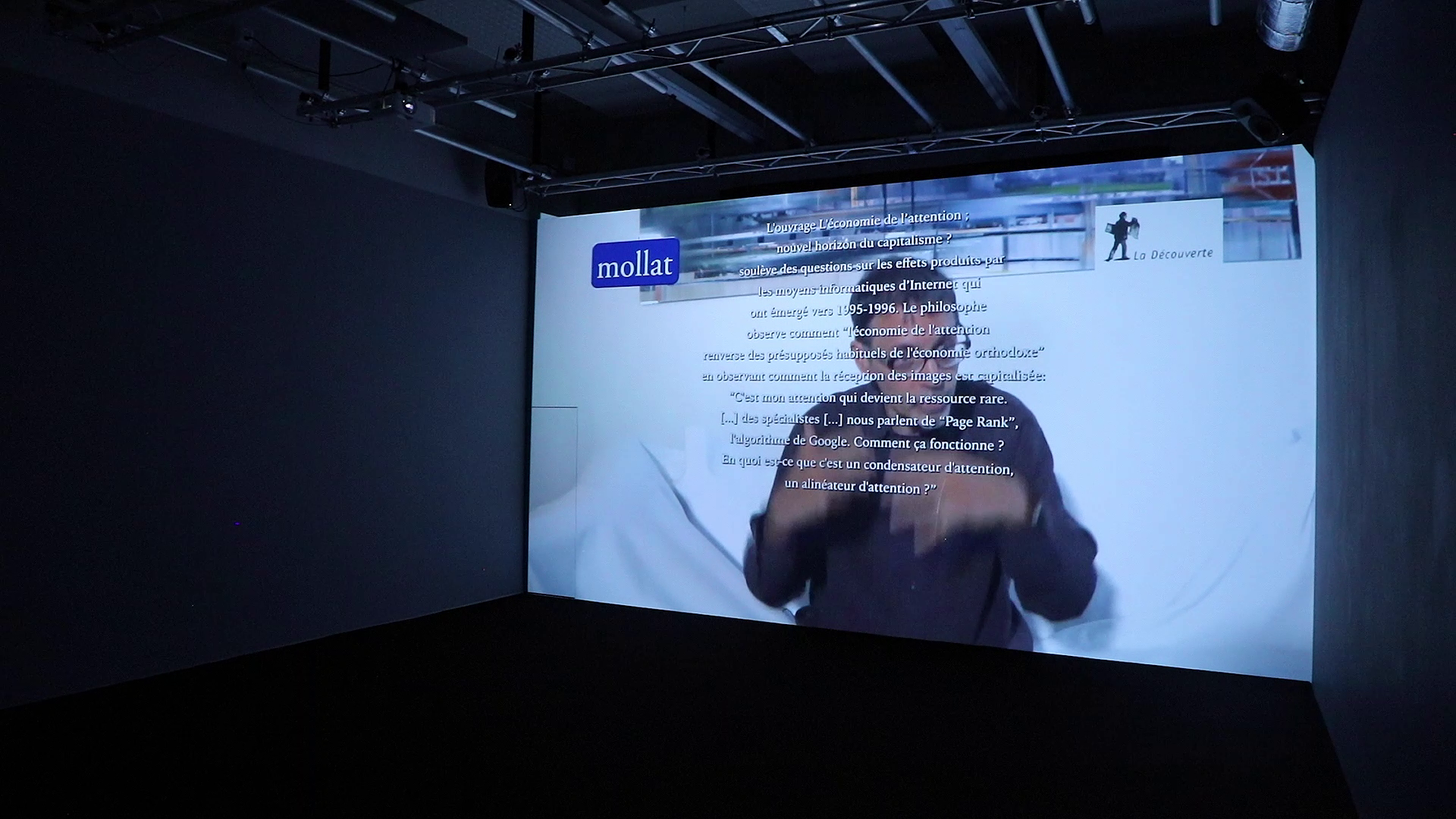
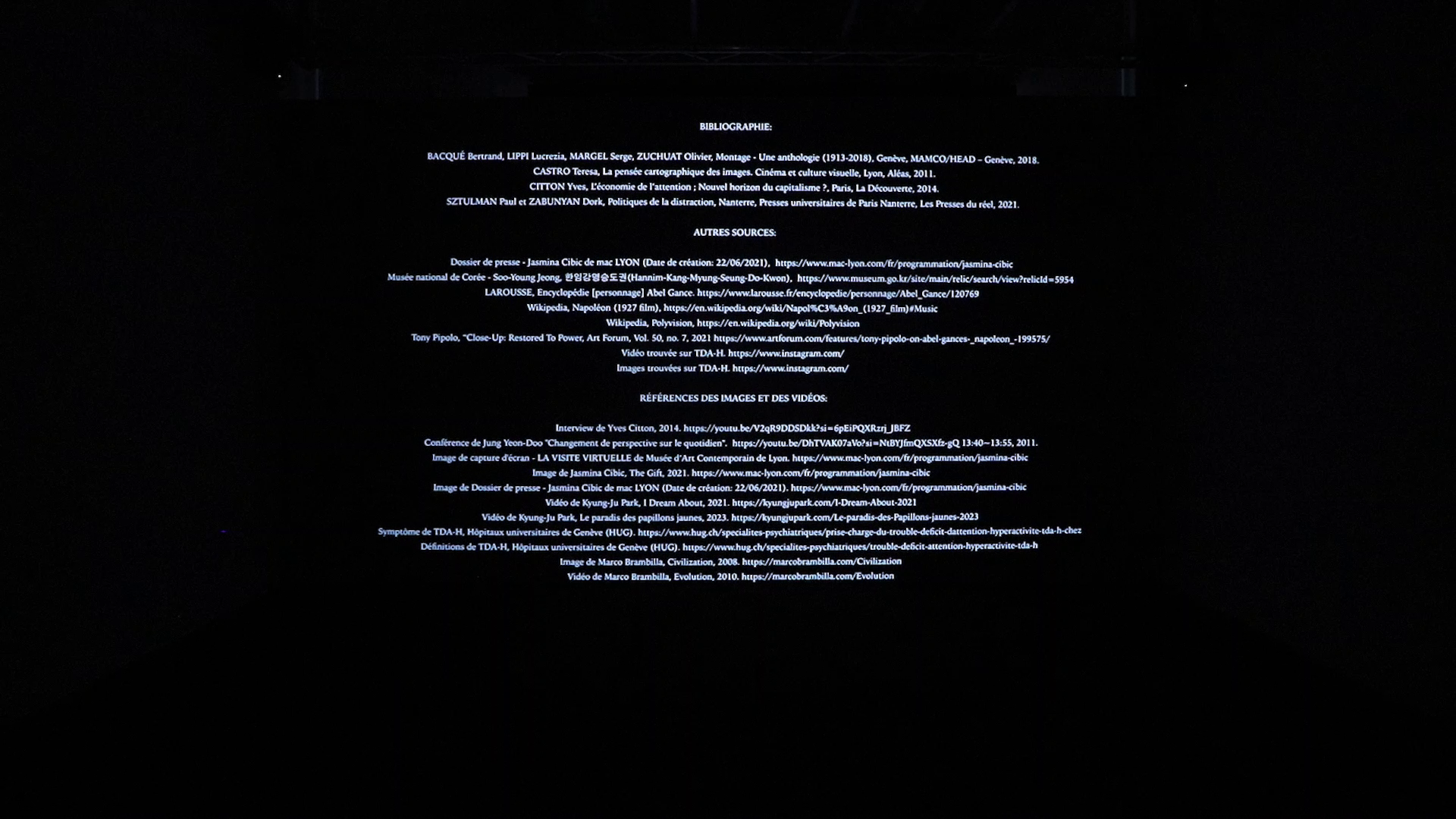
Still images from installation video
Vidéo Triptyque et Economie de l’Attention, 2024
3 Channel video installation, with sound,
23’15”, 10 x 1.8m, 5760 x 1080p. (Kr/Fr)
3채널 비디오와 주의 경제, 2024
3채널 비디오 설치 형식의 학사 논문
작가 박경주의 연구 « Vidéo Triptyque et Économie de l’Attention »은 ADHD(주의력결핍과잉행동장애)를 지닌 예술가로서의 자기 경험을 토대로, 3채널 비디오 설치가 인지적 산만함과 예술적 집중 사이의 긴장을 어떻게 매개하는지를 탐구한다. 이 형식은 병렬적 사고와 시각적 분산, 시간의 중첩을 구조적으로 드러내며, ADHD적 인식이 새로운 미학적 언어로 변환되는 과정을 시각화하는 과정에서, 작가는 인터넷 밈 등 다양한 형태의 아카이빙 이미지를 활용하여 연구의 주제를 한층 확장한다.
이 연구는 Yves Citton의 ‘주의경제’ 이론과 Paul Sztulman & Dork Zabunyan의 ‘Politiques de la Distraction’ 을 참조하여, 주의가 자본화되는 사회에서 예술적 행위의 의미를 재정의한다. 박경주는 멀티스크린 환경을 단순한 기술적 조건이 아닌, 디지털 주체성의 실험장으로 바라보며, 산만함을 결함이 아닌 창의적 리듬으로 전환한다. 본 논문은 주의경제 시대에 예술이 수행할 수 있는 새로운 인지적 미학의 가능성을 제시하며, 동시에 뉴러디버전(Neurodivergent) 아티스트들의 향후 방향성에 대한 질문을 제기한다.
Information/Fiction, 시각예술과, 제네바 예술 대학교(HEAD–Genève), 지도교수: Geneviève Loup and Frank Westermeyer.
(en)
Triptych Video and the Attention Economy, 2024
Bachelor thesis in the form of a 3 channel video installation.
Kyungju Park’s thesis “Vidéo Triptyque et Économie de l’Attention” based on her personal experience as an artist with ADHD (Attention Deficit Hyperactivity Disorder), explores how a three-channel video installation mediates the tension between cognitive distraction and artistic focus. This format structurally reveals parallel thinking, visual dispersion, and the layering of time. In the process of visualizing how ADHD perception is transformed into a new aesthetic language, the artist further expands the scope of the research by utilizing various forms of archived images, such as internet memes.
Grounded in Yves Citton’s theory of the attention economy and Paul Sztulman & Dork Zabunyan’s Politics of Distraction, the research redefines the role of artistic practice in a society where attention itself functions as capital. Park views the multi-screen environment as a site of digital subjectivity, reimagining distraction not as a deficit but as a generative rhythm. This thesis presents the potential of a new cognitive aesthetics that art can embody in the era of the attention economy, while simultaneously raising questions about the future direction of neurodivergent artists.
Information/Fiction, Visual Arts Department, HEAD–Genève, Supervised by Geneviève Loup and Frank Westermeyer.
(fr)
Vidéo Triptyque et Economie de l’Attention, 2024
Thesis Bachelor présenté sous forme d'installation vidéo triptyque.
La recherche de Kyung Ju Park, intitulée « Vidéo Triptyque et Économie de l’Attention », fondée sur son expérience personnelle en tant qu’artiste atteinte de TDA-H (trouble du déficit de l’attention avec hyperactivité), explore comment une installation vidéo en trois canaux médie la tension entre distraction cognitive et concentration artistique. Ce format révèle structurellement la pensée parallèle, la dispersion visuelle et la superposition du temps. Dans le processus de visualisation de la manière dont la perception liée au TDA-H se transforme en un nouveau langage esthétique, l’artiste élargit encore le champ de sa recherche en utilisant diverses formes d’images archivées, telles que les mèmes Internet.
S’appuyant sur la théorie de l’économie de l’attention développée par Yves Citton, ainsi que sur les analyses de Paul Sztulman et Dork Zabunyan dans Politiques de la Distraction, cette recherche redéfinit le sens du geste artistique dans une société où l’attention devient une forme de capital. Park conçoit l’environnement multiscreen non pas comme une simple condition technologique, mais comme un laboratoire de la subjectivité numérique, où la distraction se convertit en un rythme créatif plutôt qu’en un déficit. Cette recherche propose le potentiel d’une nouvelle esthétique cognitive que l’art peut incarner à l’ère de l’économie de l’attention, tout en soulevant des questions sur l’orientation future des artistes neurodivergents.
Information/Fiction, Arts Visuels, HEAD-Genève. Sous la direction de Geneviève Loup and Frank Westermeyer.
![]()
![]()
![]()
Downloard PDF file (click)
이 논문의 텍스트 파일은 3채널 비디오와 유사한 디자인을 활용하고 있으며, 비디오에서 볼 수 있는 일부 전환 효과는 포함되어 있지 않습니다.
Le fichier texte de ce mémoire utilise un design similaire à celui d’une vidéo à trois canaux, mais certaines des transitions visibles dans la vidéo n’y sont pas incluses.
The text file of this thesis uses a design similar to that of a 3-channel video, but it does not include some of the transitions seen in the video.
3 Channel video installation, with sound,
23’15”, 10 x 1.8m, 5760 x 1080p. (Kr/Fr)
3채널 비디오와 주의 경제, 2024
3채널 비디오 설치 형식의 학사 논문
작가 박경주의 연구 « Vidéo Triptyque et Économie de l’Attention »은 ADHD(주의력결핍과잉행동장애)를 지닌 예술가로서의 자기 경험을 토대로, 3채널 비디오 설치가 인지적 산만함과 예술적 집중 사이의 긴장을 어떻게 매개하는지를 탐구한다. 이 형식은 병렬적 사고와 시각적 분산, 시간의 중첩을 구조적으로 드러내며, ADHD적 인식이 새로운 미학적 언어로 변환되는 과정을 시각화하는 과정에서, 작가는 인터넷 밈 등 다양한 형태의 아카이빙 이미지를 활용하여 연구의 주제를 한층 확장한다.
이 연구는 Yves Citton의 ‘주의경제’ 이론과 Paul Sztulman & Dork Zabunyan의 ‘Politiques de la Distraction’ 을 참조하여, 주의가 자본화되는 사회에서 예술적 행위의 의미를 재정의한다. 박경주는 멀티스크린 환경을 단순한 기술적 조건이 아닌, 디지털 주체성의 실험장으로 바라보며, 산만함을 결함이 아닌 창의적 리듬으로 전환한다. 본 논문은 주의경제 시대에 예술이 수행할 수 있는 새로운 인지적 미학의 가능성을 제시하며, 동시에 뉴러디버전(Neurodivergent) 아티스트들의 향후 방향성에 대한 질문을 제기한다.
Information/Fiction, 시각예술과, 제네바 예술 대학교(HEAD–Genève), 지도교수: Geneviève Loup and Frank Westermeyer.
(en)
Triptych Video and the Attention Economy, 2024
Bachelor thesis in the form of a 3 channel video installation.
Kyungju Park’s thesis “Vidéo Triptyque et Économie de l’Attention” based on her personal experience as an artist with ADHD (Attention Deficit Hyperactivity Disorder), explores how a three-channel video installation mediates the tension between cognitive distraction and artistic focus. This format structurally reveals parallel thinking, visual dispersion, and the layering of time. In the process of visualizing how ADHD perception is transformed into a new aesthetic language, the artist further expands the scope of the research by utilizing various forms of archived images, such as internet memes.
Grounded in Yves Citton’s theory of the attention economy and Paul Sztulman & Dork Zabunyan’s Politics of Distraction, the research redefines the role of artistic practice in a society where attention itself functions as capital. Park views the multi-screen environment as a site of digital subjectivity, reimagining distraction not as a deficit but as a generative rhythm. This thesis presents the potential of a new cognitive aesthetics that art can embody in the era of the attention economy, while simultaneously raising questions about the future direction of neurodivergent artists.
Information/Fiction, Visual Arts Department, HEAD–Genève, Supervised by Geneviève Loup and Frank Westermeyer.
(fr)
Vidéo Triptyque et Economie de l’Attention, 2024
Thesis Bachelor présenté sous forme d'installation vidéo triptyque.
La recherche de Kyung Ju Park, intitulée « Vidéo Triptyque et Économie de l’Attention », fondée sur son expérience personnelle en tant qu’artiste atteinte de TDA-H (trouble du déficit de l’attention avec hyperactivité), explore comment une installation vidéo en trois canaux médie la tension entre distraction cognitive et concentration artistique. Ce format révèle structurellement la pensée parallèle, la dispersion visuelle et la superposition du temps. Dans le processus de visualisation de la manière dont la perception liée au TDA-H se transforme en un nouveau langage esthétique, l’artiste élargit encore le champ de sa recherche en utilisant diverses formes d’images archivées, telles que les mèmes Internet.
S’appuyant sur la théorie de l’économie de l’attention développée par Yves Citton, ainsi que sur les analyses de Paul Sztulman et Dork Zabunyan dans Politiques de la Distraction, cette recherche redéfinit le sens du geste artistique dans une société où l’attention devient une forme de capital. Park conçoit l’environnement multiscreen non pas comme une simple condition technologique, mais comme un laboratoire de la subjectivité numérique, où la distraction se convertit en un rythme créatif plutôt qu’en un déficit. Cette recherche propose le potentiel d’une nouvelle esthétique cognitive que l’art peut incarner à l’ère de l’économie de l’attention, tout en soulevant des questions sur l’orientation future des artistes neurodivergents.
Information/Fiction, Arts Visuels, HEAD-Genève. Sous la direction de Geneviève Loup and Frank Westermeyer.


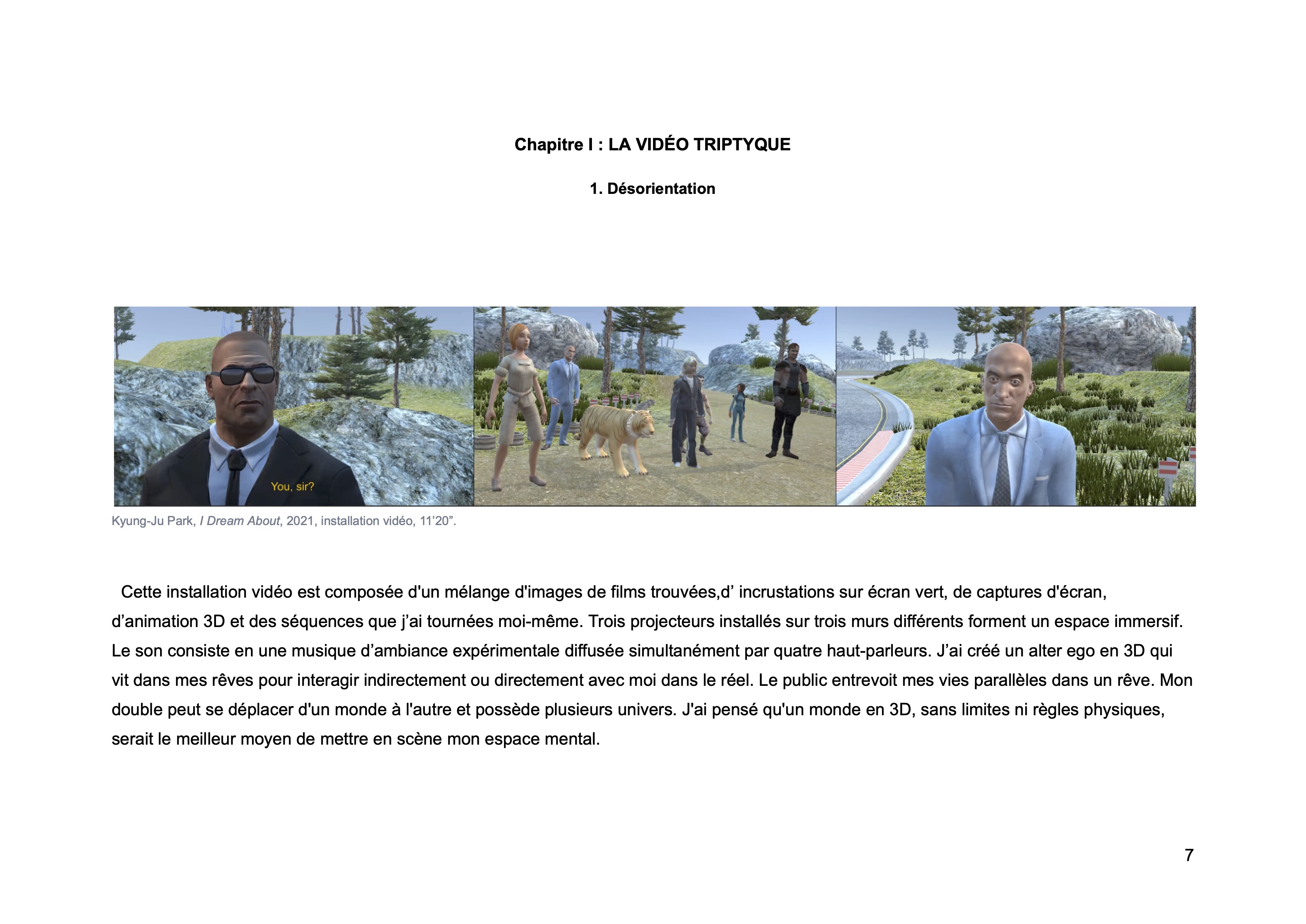
Downloard PDF file (click)
이 논문의 텍스트 파일은 3채널 비디오와 유사한 디자인을 활용하고 있으며, 비디오에서 볼 수 있는 일부 전환 효과는 포함되어 있지 않습니다.
Le fichier texte de ce mémoire utilise un design similaire à celui d’une vidéo à trois canaux, mais certaines des transitions visibles dans la vidéo n’y sont pas incluses.
The text file of this thesis uses a design similar to that of a 3-channel video, but it does not include some of the transitions seen in the video.